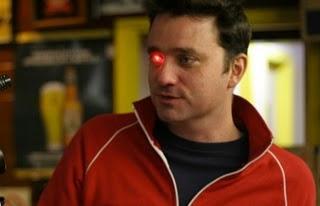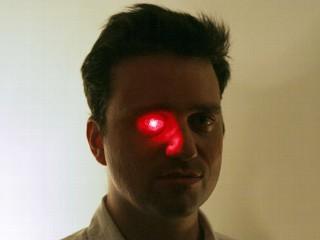[starttext]

Filmmaker Rob Spence shows a prosthetic eye with a red LED. Spence is working with an engineer to create a prosthetic embedded with a wireless video camera.
Canadian filmmaker Rob Spence, who lost an eye in a childhood accident, is determined to replace his artificial eye with a video camera and said he's almost there.
Like the fictional bionic man, Spence wants to transform his loss into a superhuman strength. But instead of using his enhanced ability for secret agent-type espionage, he wants to use it for his art.
Calling himself an "eyeborg," the 36-year-old, who is originally from California, wants to produce videos with his camera eye that explore privacy and surveillance issues. As surveillance and other hidden cameras increasingly monitor our daily lives, Spence wants his unusual perspective to serve as a check.
"We're sleepwalking into an Orwellian society," he said. "There's surveillance, but who's doing the surveillance. Who's watching the watchers?"
Last week, for the first time, he and his team succeeded in outfitting his prosthetic eye with an electronic device.
Although it wasn't yet a camera, the red LED gave them (and potential supporters) confidence that a prosthetic eye could house a working device and battery.
"This is every adult male's fantasy," Spence quipped. And though it's a minor detour, he hopes it will draw attention to grander plans.

[endtext]The Eyeborg Project
Spence lost his eye when he was 11 years old. He was playing with a gun at his grandfather's farm in Ireland; when it backfired, it severely injured his eye. Years later, he had his eye removed.
As a filmmaker, wanting to turn his eye into a camera is only natural, he said.
He's been working with his ocularist and a couple of camera companies for a while, but launched a blog in November to officially announce his plans.
In January, he migrated his blogspot to a dot-com and revealed the Eyeborg Project.
Along with Kostas Grammatis, a former SpaceX avionics systems engineer who joined the project after reading a Wired story about him in December, Spence is working with Santa Clara, Calif.-based Omnivision, Inc., and RF-Links in Toronto to develop the working camera eye.
Wearable Video Camera Is Feasible
Omnivision develops the tiny cameras used in phones, laptops and medical equipment. RF-Links specializes in wireless audio and video equipment.
The team recently succeeded in creating a prosthetic eye with a video camera that allowed Spence to transmit video for about three minutes. But, Grammatis, 23, said the image quality wasn't good enough to share.
"We have some other prototypes coming down the pipe," Grammatis said. "What we've demonstrated is its feasibility."
He said they want to wait for a broader debut when they've managed to create a device that can record producation-quality film.
One-Eyed Artist Also Seeks Webcam Eye
However, as incredulous as it may seem, Spence isn't the only one-eyed creative looking to replace an artificial eye with a webcam.
In November, Tanya Vlach, a San Francisco artist sent ripples through the blogosphere when she posted a "call for engineers" on her Web site, asking for advice on a bionic eye.
After Vlach lost her left eye in a 2005 car accident, the 35-year-old artist launched a blog to document her experience.
Titled One-Eyed, the site is about "the future of sight, a chronicle of her adjustment to a monocular life."
Given the preponderance of miniature cameras in cell phones, webcams and other mobile cameras, she wondered whether a camera small enough to fit in her prosthetic eye might also exist.
Vlach said she's been working on a documentary about her accident and researching the eye-cam idea for more than a year.
"It was my way of recreating the eye that I lost," she told ABCNews.com in November.
Although the two have separate projects, they're in contact and, Spence said, are actually planning a "one-eyed party" in San Francisco for later this year.
But it isn't just one-eyed artists who are interested in wearable technology that records and transmits video of the day-to-day.
Spence said he has been working with Steve Mann, an MIT graduate and University of Toronto engineering professor who is a pioneer in wearable computing.
For the last 30 years, Mann has lived as a "cyborg" glogger -- short for cyborg logger -- with a wireless video camera that allows him to transmit the daily events of his life to the Internet .
Glogging Preceded Blogging
Mann said about 30,000 gloggers around the world use a transmitting video camera strapped to some part of their body to broadcast the events of their lives with others via the Web.
Like Spence, they want to be able to document their lives and share their perspectives. But instead of writing about their experiences on blogs, they simply share the video.
"Glogging has been around a lot longer than blogging," Mann said.
And, Spence said, it has a special effect on the imagination.
"It taps into some kind of immature pop culture supero hero fantasy," he said.
Copyright © 2009 ABC News Internet Ventures

